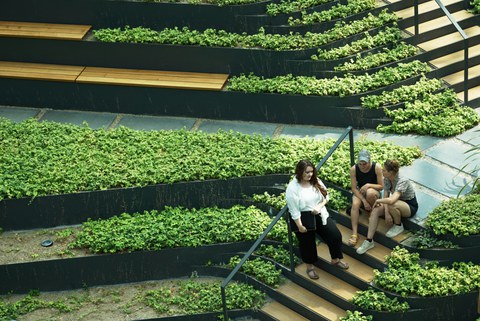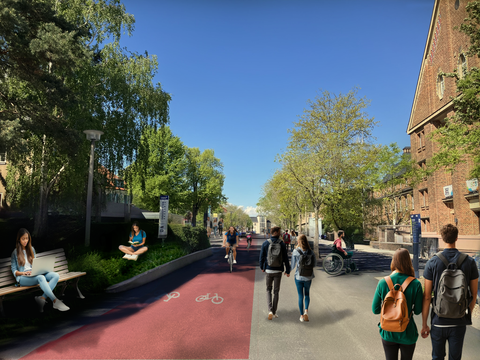Campusleben
Nachhaltig, inklusiv, lebendig - das Campusleben an der TU Dresden bietet Raum für Lernen, Arbeiten und Begegnung. Mit nachhaltiger Infrastruktur, grünen Freiflächen und modernen Lernorten schafft die Universität eine Umgebung, die akademische, soziale und ökologische Bedürfnisse gleichermaßen berücksichtigt. Der Campus fördert Gemeinschaft, Teilhabe, Gesundheit und Innovation – und unterstützt Studierende und Mitarbeitende in ihrer persönlichen und fachlichen Entwicklung. So entsteht ein lebendiger, offener Ort mit hoher Identifikation.
(Im gesamten Abschnitt finden sich Querverweise zu Nachhaltigkeits- & Universitätsentwicklungsstrategie)

Studierende beim digitalen Lernen auf dem Campus TUD
Was wollen wir?
Unser gemeinsames Ziel ist es, einen grünen Campus zu schaffen, der Nachhaltigkeit und Lebensqualität vereint. Wir wünschen uns daher einen Campus, der durch freundliche Atmosphäre, Helligkeit, Ruhe und Offenheit überzeugt und auf dem sich die verschiedenen Akteur:innen der Universität gern aufhalten. Durch die grüne, offene, sichere und funktionale Gestaltung ermöglicht er Begegnungen und fördert gemeinsames Lernen, innerhalb der TU Dresden-Community wie auch mit der Zivilgesellschaft. Es soll ein dynamischer und zukunftsorientierter Campus werden, der die Bedürfnisse der heutigen und kommenden Generationen von Studierenden, Lehrenden und Mitarbeitenden erfüllt.
Wo wollen wir hin?
Der grüne Campus der TU Dresden verbindet vielfältige Begrünung mit nachhaltiger Energiegewinnung: Dächer und Fassaden sind begrünt oder mit Solarpanelen ausgestattet, öffentliche Flächen bepflanzt und einladend gestaltet. Es gibt zahlreiche bequeme, teils überdachte Sitzgelegenheiten sowie wettergeschützte Arbeitsplätze mit Stromanschlüssen. Wasserspender und frei zugängliche Toiletten sind campusweit verfügbar. Der autofreie Campus ist über Park-and-Ride, den ÖPNV sowie ein dichtes Rad- und Fußwegenetz gut erreichbar. Eine fahrradfreundliche Infrastruktur mit überdachten Abstellplätzen und Reparaturstationen ergänzt das Mobilitätsangebot.
Die Atmosphäre ist ruhig, offen und einladend. Lernräume sind unkompliziert zugänglich, viele rund um die Uhr nutzbar. Für ein gutes Raumklima sorgen Licht, Belüftung und Klimaanlagen, Wege und Gebäude sind gut beleuchtet. Die Universität unterstützt eine gesunde Lebensweise, z. B. durch kostenloses Obst bei Veranstaltungen und einfache Versorgung mit Wasser, Kaffee und Tee.
Alle Neubauten und Sanierungen folgen einer nachhaltigen Bauweise mit umweltfreundlichen Materialien und dem Ausbau erneuerbarer Energien. Barrierefreiheit ist auf dem gesamten Campus – physisch wie digital – selbstverständlich. Für Forschung und Innovation, insbesondere in den Bereichen Nachhaltigkeit, Umwelt und digitale Bildung, stehen gezielt Räume und Ressourcen zur Verfügung.

Campus der Zukunft - Bild ist KI generiert
Wie erreichen wir das?
- Kernzonen des Campus autofrei gestalten, d. h. Straßen zu Radwegen machen, Grünflächen schaffen (bspw. in Zusammenarbeit mit Landschaftsarchitekt:innen der TU Dresden); Nachhaltigkeit auch in Hinblick auf Wasserverbrauch und Tierschutz anstreben
- Integration von grünen Dächern und begrünten Fassaden oder Solarpanels auf Gebäuden zur Energiegewinnung
- Installation von Solarenergieanlagen und anderen erneuerbaren Energiequellen auf dem Campus
- Auf jeder (größeren) Rasenfläche Tische und Stühle installieren
- Fahrradständer fest verankern und überdachen
- Stromleitungen verlegen
- Wasserspender installieren
- Kooperation mit regionalen Landwirten
- Integration von umweltfreundlichen Baumaterialien und energieeffizienten Systemen in neue Bauprojekte
- Renovierung bestehender Gebäude unter Berücksichtigung von Nachhaltigkeitsstandards
- Implementierung von Energiesparmaßnahmen, wie energieeffiziente Beleuchtung und Heizsysteme
- Umgestaltung von Campusbereichen, um barrierefreien Zugang für alle Menschen zu gewährleisten
- Implementierung von barrierefreien digitalen Plattformen und Online-Ressourcen
Die Umsetzung dieser Maßnahmen erfordert eine enge Zusammenarbeit zwischen Hochschulverwaltung, Fakultäten, Studierendenvertretungen und anderen Interessengruppen. Ein umfassender Plan und eine klare Kommunikation sind entscheidend, um die gewünschten Veränderungen erfolgreich zu implementieren.
